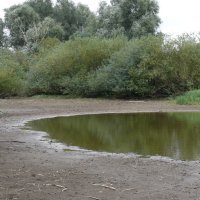 Bildrechte: B. Königstedt
Bildrechte: B. KönigstedtGroynes and Riverbanks
In comparison with other major Central European rivers, the banks of the Elbe within the scope of the biosphere reserve are relatively unaffected by human intervention. Since the end of the nineteenth century, groynes have been used to ensure the navigability of the Elbe. The groynes, supported by masonry or simply dumped rock, jut out from the banks into the river course. Since the construction of the groynes, the calm waters of the so-called groyne fields between them have become the recipients of large quantities of the material which the river carries with it. In this way, substitute habitats have developed to replace the sandbanks and mudbanks, erosion shores and shallow water zones which used to characterize the Elbe. These locations provide a place for young fish to develop, for breeding birds like the greylag goose (Anser anser), cranes (Grus grus) and lapwings (Vanellus vanellus) and for grey herons (Ardea cinerea) and cormorants (Phalacrocorax carbo) searching for food. Even the larvae of an endangered species of dragonfly, the river clubtail (Gomphus flavipes), adapted to life close to large rivers, can find shelter in the groyne fields.
When the water level in the Elbe recedes in summer, extensive sandbanks and mudbanks appear. These open, damp spaces provide an opportunity for transitory pioneer vegetation to develop. In the drift line this often consists of small, inconspicuous species such as strapwort (Corrigiola litoralis), bristleseed sandspurry (Spergularia echinosperma) or moist bank pimpernel (Lindernia dubia). The neighbouring, nutrient-rich spaces are generally taken over by metre-high beggartick varieties (Bidention tripartitae). As well as many species of goosefoot (Chenopodium) and saltbush (Atriplex), the lion’s tail (Leonurus marubiastrum) can also be found – a plant whose distribution is largely restricted to the valleys of the Elbe, Saale and Oder. The Lombardy poplar (Populus nigra) is another river-bound species which uses waterway corridors as its natural means of dissemination.
Some of these species are fairly recent arrivals in Europe, so-called neophytes. Such species are often introduced as ‘stowaways’ in ships’ cargoes. This was the case with the moist bank pimpernel (Lindernia dubia), a native of North America. It was first identified in Europe in 1851, and in the Elbe valley in 1963. Another species now characteristic of the Elbe region is the endemic ‘Elbspitzklette’, which originated from the riverside cocklebur. The neophyte was observed in Europe for the first time in 1830, and since then this immigrant has developed into a species in its own right. Its oval seeds are equipped with hooked appendages which easily cling to the fur or feathers of passing animals. It is spreading along the Elbe as well as its tributaries Havel and Spree. With its special habitat preferences, it remains confined to the river valleys.
The vegetation immediately adjoining the river generally consists of reed beds and other tall herbaceous plants which need moist conditions. In their element, plants such as reed canary grass (Phalaris arundinacea), reed (Phragmites australis), bindweed (Calystegia) and masses of stinging nettles (Urtica dioica) grow up into impenetrable thickets.
A little further away from the river a strip of riparian forest has developed. This contains softwood trees such as white, purple and basket willows (Salix alba, Salix purpurea, Salix viminalis). Here, too, the Lombardy poplar is another representative of the typical river valley tree species.
 Bildrechte: B. Königstedt
Bildrechte: B. KönigstedtWhen the water level in the Elbe recedes in summer, extensive sandbanks appear.



 deutsch
deutsch english
english